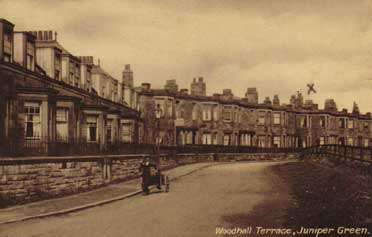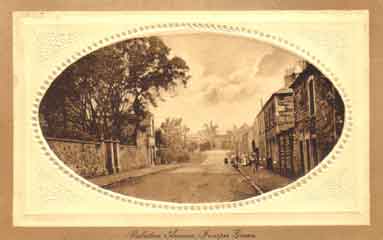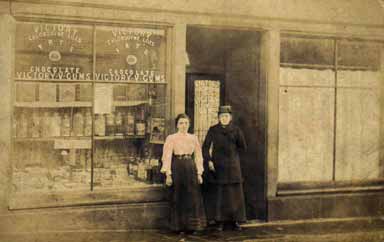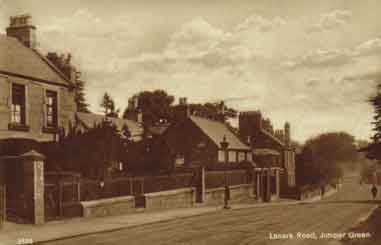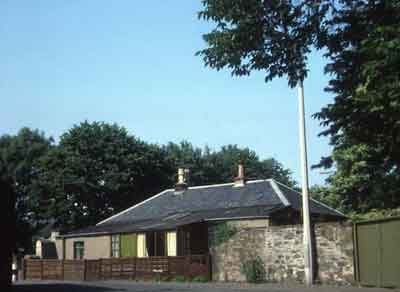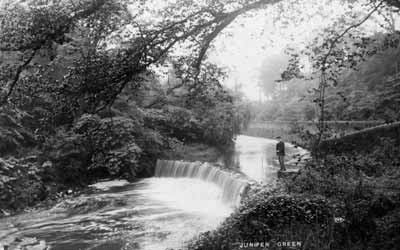Memories of Juniper Green from 1930
I remember...
In 1930, I stood beside my father looking out of the upstairs window of 7 Woodhall Terrace with, before us, an expanse of green field stretching uninterrupted to the red sandstone of St. Margaret's church and its bell tower. Beyond lay the Pentland Hills with the minor scar of a quarry at its foot. As we watched, a lone figure with a gun below his arm strode purposefully toward the back gardens of Baberton Avenue. This figure I came to know later was Mr Howitt, the local joiner and undertaker, returning to his home and workshop after a rabbit hunting expedition.
School memories
I attended the school on the corner briefly. I sat at my desk, always the same desk. My teacher was Miss Mulholland, Miss 'Nell' Fraser was the headmistress and Mr Hutchison the janitor. The school was bright and airy, lots of glass, doors banged and echoed throughout its open hall. A strict sense of discipline prevailed with girls having priority over boys in queuing to enter the school as the hand bell was rung. It was only two minutes from my home and I enjoyed a sense of open freedom after living within the confines of Edinburgh.
Baberton avenue was the route to the village In 1930, Woodhall Drive had not been built and Woodhall Terrace ended with the last house, number 16, terminating before a grassy bank and yet another field. The 'link up' with Foulis Crescent had not yet commenced. When it did, the new five hundred pound Bungalows provided us with a wonder playground after hours when the workmen left. There was a night watchman who would sit before a brazier at his small shelter, this proved a magnet for us as children where we would sit and exchange stories.
The school janitor's house was at 28 Baberton Avenue. Mr Hutchison's son Matthew and I made a den in his garden: dens were just harmless little hideaways which could magically become forts, igloos, or even aeroplanes. Mr Howitt's joinery premises were there also, sawing and machinery noises and the smell of newly cut wood. Mr Howitt had a son and two daughters, Nan and Jean who would brighten the scene at the swimming pool at the falls when they appeared as bathing beauties. Further down the avenue lived another school friend Hugh Horne, Hugh died and it was difficult for me to understand and cope with at my early age. Across the road between the hedges lay Miss Linton's sweetie shop; this was superseded by another sweetie shop, Bensons.
Golf Course, Hall and Park
At the approach gates to the golf course would stand a number of younger men in the hope that they may be engaged as golf caddies. Two and sixpence (12 pence) a round was the caddie's fee. Turn left behind the cottages in front of the village hall, demolished to make way for construction of premises to cook school dinners for the region, demolished in turn to provide the present housing. But, rather remarkably, the tennis courts and the village hall have survived these years virtually unchanged and largely due to the efforts of worthies like Mr Culbert and others who had the foresight to preserve these amenities.
Step further through the park gates where Alec Shields was lord and enforcer of all who tread within. He once dismissed Harold Ramsay, my brother in law, for the crime of sitting in the park shed and playing his ukelele. On Saturdays the Juniper Green football team may take on Currie or Slateford. I liked to stand behind Bert the Juniper goalie in his yellow turtle-necked shirt and on Sunday with a couple of pals I took my beloved rugby ball and we kicked to 'gain ground' beyond each other.
Sunday school picnics were held there also. A tin mug hung on a tape over your shoulder for refreshment, ice cream, fruit, sandwiches and races were enjoyed.
Lanark road ( from east to west)
On the corner of Baberton avenue and Lanark road,( 540 now a hairdresser) Bill Scott had his grocery store. I can recall Bill's father serving in the shop. The floor sloped down sharply as you entered, and the long counter was on the left. All transactions were made over the counter with loose items being scooped into brown paper bags folded, weighed and tied with string which Bill wound around his fingers and snapped with great dexterity. Sometimes I was just given a list by my mother and these items were made up and delivered by a bike with a carrier on the handlebars.
At 536 was Lizzie and Willie Forsyth's fruit shop. Much of it was in the open and it was always resplendent with fresh fruit and vegetables. Willie suffered an infirmity to his back, but they both worked very hard. Over the road the post office, (still there), was run by Jessie Graham for many years and you could purchase newspapers there. Often, to be seen outside was the telegram boy in his smart red and navy uniform and pillbox hat. He had a red bicycle which was his duty to keep clean. If the telegram which he was to deliver contained sad news then Jessie would tell him to deliver it quietly, always personally, and wait to see if an answering telegram was to be taken back to the post office. These telegrams came in yellow envelopes which I am sure are still treasured for their contents throughout the land.
One of my pals, Willie Bruce would be up at five in the morning stamping out pie crusts at Graham the bakers before going to school. Grahams became a building society then a funeral directors' (553).
Across the road was Hutton's, an 'everything' shop which changed little but the name when it became Porteous' shop. ( 558) It always retained that hardware smell, its source still unidentifiable to me.
Up the hill a bit to Cattanach's, a grocery store to rival Scott's. A small fish shop adjoined it, now a delicatessen grocery and a butchers.
The next location, now occupied by 'Iceland' held Bryce's petrol pumps (598). These were hand operated pumps. But relatively few cars were on the streets. There were but two car owners on Woodhall Terrace: the gent at number one and Mr Smith at number ten. Mr Maguire, who lived in the last house in the terrace, used taxis.
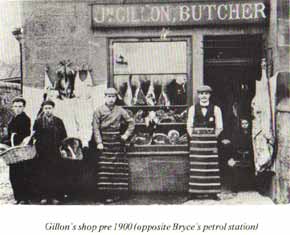
569 Lanark Road was a butcher shop at one time before it became Granny Young's sweetie shop. The iron hooks on which the meat would have been hung remain visible outside today's electrical shop.
Opposite Bryce's petrol pumps at 569, open the door to 'Granny' Young's sweetie shop, now an electrical shop. It always took Granny Young a long time to come through from the back and you would get an uneasy feeling that something had happened to her. Behind her shop was a garage housing a variety of vehicles, an AA patrol man's yellow motor cycle and side car (if you displayed an AA badge on your bumper he would salute in passing), saloon cars gleaming and smelling of leather with racks on the back for travel trunks and metal vases for flowers on the dashboard. Cross again to another corner ( 610) and down a few steps to 'Granny' More's to retrieve your wireless 'accumulator', a wet acid filled battery which together with a large biscuit tin size 'dry' battery required to be connected to your wireless in order for it to perform. The 'wet' battery had to be charged periodically and you left carrying it cautiously with Granny More's words ringing in your ear, "Noo, dinnae git ony o' that acid on yer claes".
Before turning the corner to go downhill, look over to 'Stewart's'. Stewart's sold some groceries of the canned variety, sweets, newspapers and a bubbly drink called a Vantas. This was created before your very eyes by a machine which belched a bit and eventually disgorged a fruity, but cheap and palatable, cold and fizzy drink. One flavour I think, but definitely the cheapest, matched only by Tizer. Another value for money confection was the Double Six a chocolate bar oversized compared with its contemporaries.
The Kinleith Arms.
It was divided into two areas. In one the dartboard, and what would now be called the public bar. On the other side rooms with doors into which you could sit with your wife or lady friend. In 1946 my father carved and painted a panel which is on the wall to this day. It depicts Rabbie Burns addressing some of the local Juniper worthies of that day (1946). Foremost with the pipe is Bob Hamilton who was the chimney sweep, and the publican stands with folded arms. Bill Steel is prominent, Bill held the title of The Queen's Royal Remembrancer. He was responsible for the preservation of treasure trove and to an extent, custom duties. This led to his involvement in the wreck of the SS Politician made famous in the film Whisky Galore in which a vessel is wrecked on a Western Isle, its whisky cargo washed ashore to the delight of the islanders. Unaccountably, much of this whisky vanished who knows where, but Bill confessed to me that he had experienced the joy of "a drop of Politician" (for more details on the painting see the item on the Kinleith Arms elsewhere on this website).
The other hoose, the Railway Inn was run by John Bennet, John had two worthy Sons, John and Albert. John would stand behind the bar cooking beans for his supper on a gas ring. Albert married Peggy Collier and emigrated to California USA.
The store
Next to Stewart's and now an optician's was the largest Juniper Green shop The Store, the Cooperative Wholesale Society. You obtained a 'store number' which you quoted on making a purchase. This entitled you to a 'dividend' on the share system. This divvy usually became payable before the new school year, and was invaluable in helping to purchase uniforms etc. Behind the 'store' lay the 'store stables' in which the Clydesdale horses which pulled the store carts were kept. These horses were groomed and adorned in shiny leather and brasses, feathered tails and manes. Accompanied by costumed characters they would assemble beside the school and in Woodhall Terrace for judging and prize giving prior to setting off collecting for charity. This was the annual pageant.
Juniper Avenue( formerly Belmont Avenue)
On the right was the Smiddy, the village blacksmith, A great place to go on school holidays or Saturday mornings. If a horse was being shod it became a magical world, a glowing fire in the background. The smoke and steam, the ringing of the anvil as the shoe was hammered to shape. The way the smith deftly held the hoof between his knees and the scent as the hot iron shoe was fitted to the hoof and nailed in place. The smith was very obliging and could quickly turn you out a gir, an iron ring with a looped rod attached. You simply ran alongside the ring as it rolled, controlling it with the looped rod. Your steps seemed ever lighter as you went along, its sound ringing in your ears. Or, he would make you a simple 'cleek', a bar with a hooked end which you could take to Largo or North Berwick and rake out crabs from below the rocks.
Cross the road down the hill and find Miss Bryce's dairy on the left. I have carried many pewter 'pitchers' of milk to and from that dairy - a reward of a sweetie usually went with this transaction. Turn another corner to return toward the school. In the 1980s 'Barney Battles' the noted Scottish footballer lived here at 76 Belmont Road.
The Railway and the mills
Next to the post office, now a Christmas tree sales and parking area, stood the home of Mr Blackwood, the station master. He had a daughter Jean. The railway was the LMS (London, Midland and Scottish). His duties were to look after the station which had large white swing gates each side of the railway line. These gates were opened as vehicles arrived to approach Woodhall paper mill on the other side of the tracks. The station had a long platform with an adjoining ticket office, waiting room and toilets. Timetables and colourful posters adorned the walls and flowers were liberally planted. A competition existed between the stations for maintenance. A five shilling (twenty-five pence) season ticket provided limitless travel between Juniper Green and Edinburgh for a month. The other direction took you to Currie and Balerno, the terminus. A single track railway, it carried coal to the paper mills and paper from the mills. A risky escapade was to place a penny on the rails before an advancing train. The result (if you could find it) was a large, very flat, thin penny. Behind the station under large roofs were the freight yards with carriages awaiting loading or unloading. These carriages had destination labels clipped to them, mischievously we wondered what would happen if we switched them, but we never did.
The tunnel from above the falls containing the mill lade or lead emerged here. It had passed below the railway. It then traveled openly some several hundred yards to the snuff mill which was powered by a large water wheel, driven by the current from this channel. Snuff was manufactured from a tobacco product, and strangely after it had long been demolished, on a damp warm day one could detect the scent of snuff among those tumbled stones. Close by was a signal box, a small hut accessible by ladder in which the signalman would control the signals and points by the use of hand operated levers. Toward Woodhall paper mill, jocularly known as 'the mangle', in comparison with its giant competitor the Kinleith mill. A stone wall stood above a waterfall. This has since been blown up and now forms rapids. Below the falls a pool of some six feet in depth had formed providing an excellent swimming pool. Above this was built a concrete structure containing two 'sluices' one a large mechanically geared gate to shut off the water traversing the tunnel to the snuff mill, the other a hand operated sluice which, when lifted, by passed the waterfall providing a strong stream of water to the lower river level. When lifted and opened it was pleasurable to sit in this strong current, but its action would reduce the flow of water to the wheel and thus diminish its action.
Enter Mr Will Law, the water guardian responsible for the river environs, his daughter Nessie lives in the village and can confirm this story. Will would wave his stick, shout, and quickly the water flow would be returned to normal. Although enraged at our sluice activities he was nevertheless a great champion of the young.
Camping beside the river
Matthew and I would camp beside the railway on a Saturday night at Wylie's. Mr Wylie owned the land below the bridge to Blinkbonny. He kept white Shetland ponies and these ponies would play their parts at pantomimes in Scotland, pulling Cinderella's carriage and similar shows. We would leave home with a "see you tomorrow" to our mums and dads and set out to camp, often times not without incident: once I suffered a black eye as a bar of soap hit me, thrown back by my pal as I entered the tent, and again a can of beans placed to heat up exploded, leaving me spattered with an all body rash. I was wearing a swimming costume at the time. This didn't arouse any great excitement on our return home, our parents just accepted the fortunes of our private expeditions. We would build tree houses forty feet in the air, compete on who could carve their initials highest on the trunks. I derive great pleasure from still being able to view these still-legible acts of vandalism. We revelled in what we thought was our total independence and withdrawal from the world. But, now I know that the redoubtable Will Law would be keeping his eye upon us and assuring our families that we were OK.

